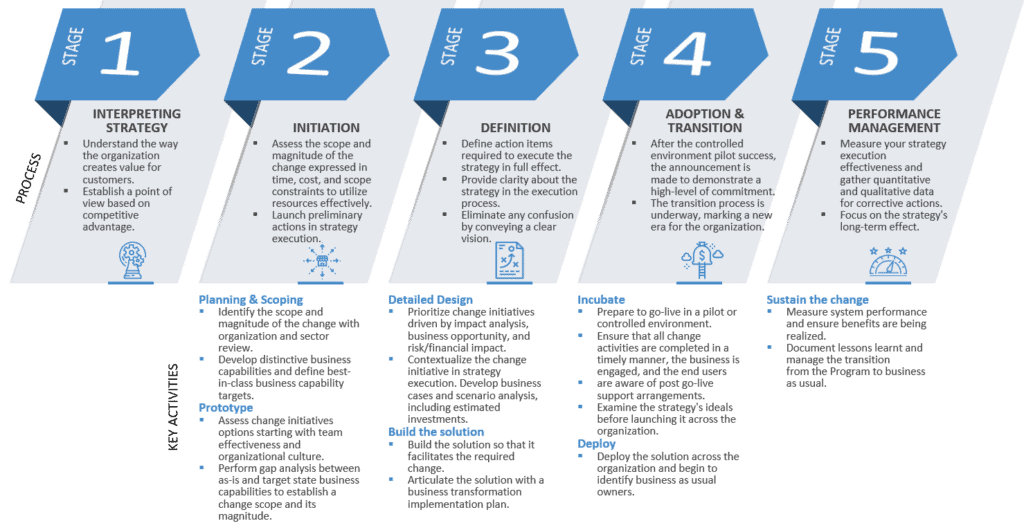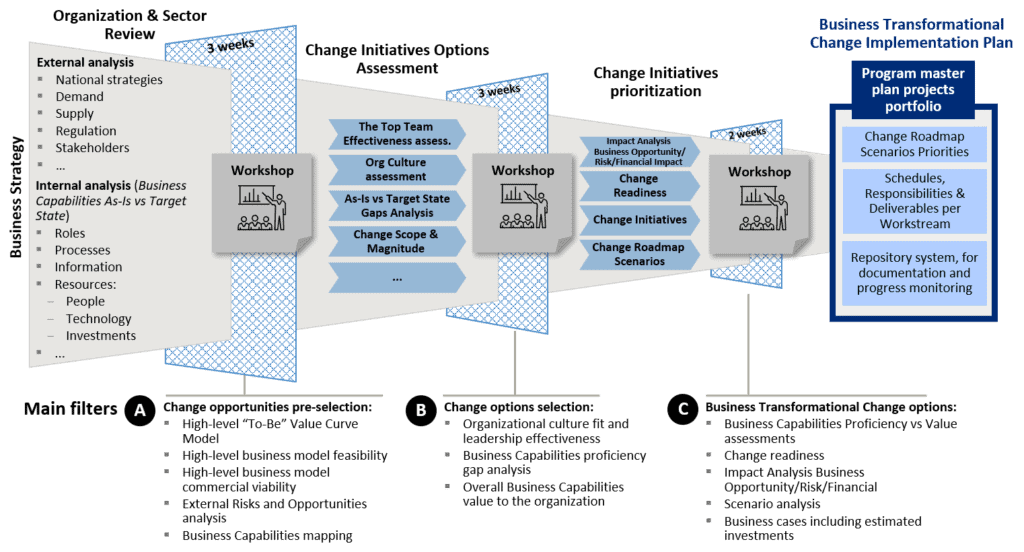Key Activities in Effective Strategy Execution

As we pointed out in “Strategy Execution Anchored in Business Capabilities”, over 80% of organizations fail to execute their strategies effectively (Sull et al., 2015). In most cases, failure to execute a strategy is caused by poor execution, not due to a poor strategy. To that end, we believe that the need for and advantages of a logical and pragmatic rationale for effective strategy execution business process are quite apparent in large organizations. A process forms the lifeline for any business and helps it streamline tasks, making sure that resources are put to optimal use.
A Business Process is a Series of Steps Consisting of Tasks
Executing a strategy involves a series of steps and procedures that help contextualize the various components of the comprehensive process (Wasserman & Czarnecki, 2014). The steps are directly tied to the practical process of executing a strategy, and the systematic process provides a rationale for effective strategy implementation. The role of each step is vital in enhancing the success or control of the entire course of strategy execution.
The enterprise transformation model involves the following steps: Planning and Scoping, Prototype, Detailed Design, Build the Solution, Incubate, Deploy, and Sustain the Change.

Stage 2 – Step 1: Planning and Scoping starts with identifying the magnitude and scope of the transformation by considering the sector and the organization. During this step, organizations create unique business capabilities and define superior organizational capability targets. It involves mapping and measuring of business capability’s supporting components (roles, processes, information, investments, technology, etc.).
The gap between As-Is and Target State identified thorough assessment of the capability proficiency level (i.e. ability to execute capability) and capability value to the business among business-critical capabilities (i.e. business capabilities with the greatest impact on the success of the business) will lead to requisite clarity required for prioritization among change initiatives. One of the greatest challenges organizations face is enhancing the success level of strategy execution (Srivastava & Sushil, 2011). The lack of research on strategy execution during the initial phase is a major factor contributing to the poor implementation of a strategy.
Stage 2 – Step 2: Planning and Scoping step involves assessing change initiative alternatives beginning with organizational culture and higher team effectiveness. Gap analysis is vital in determining the exact magnitude and scope of change. Building capacity to execute the transformation is a major trial for contemporary organizations. Implementing a novel plan involves aligning internal capabilities and resources to the organization’s reality and modifying them to external impositions and needs (Fedato et al., 2015). The effective execution of a strategy stems from the mutual evolution of processes, systems, and stakeholders within organizations.

Stage 3 – Step 3: Detailed Design leads to prioritizing change initiatives based on impact analysis. It enables the contextualization of change initiatives in strategy execution (Radomska, 2014). It also involves creating business cases and scenario analysis, including determining estimated investments.
Capabilities-driven strategy equips organizations during continuously stormy circumstances. Although developing a capabilities-driven strategy (CDR) is simple, implementing it is challenging, particularly during economically volatile times (Robinson, 2019). It is not recommended to hibernate or wait for the economic storm to pass during crises, considering that it may take longer to pass.
Stage 3 – Step 4: Build the Solution, it is vital to develop the solution to enhance its ability to attain the transformation and communicate it across the organization with a business change execution plan. Building the solution helps enhance its ability to change the organization effectively (Radomska, 2014). The solution should be developed and reinforced to ensure that it effectively facilitates the organization’s required transformation. All options should be considered when building a strategy in the internal and external environment.This is the last step of the process stage Definition outlined in the illustration above (Figure 2).
Stage 4 – Step 5: Incubating is about preparing to launch in a pilot or controlled environment. Efforts should be made to ensure that all actions are completed on time, and users and businesses are engaged for purposes of post-launch support arrangements. During this step it would we recommendable to kick off a Business Transformation Office (BTO).
Incubation helps examine the strategy’s ideals before launching it fully (Wasserman & Czarnecki, 2014). The process helps the organization to appraise the strategy and make necessary changes before launching it all over the organization. Launching a strategy before piloting may expose the organization to many problems due to its flaws.
Stage 4 – Step 6: Deploy the Solution; once the solution has been launched and tracked for some time in a controlled environment, the transformation should be deployed simultaneously all over the organization. It is critical to assess system performance during this step, thus guaranteeing the realization of transformation benefits. Initiating the solution is the pinnacle of strategy execution since it puts the strategy into practical application. Strategy execution is a practical process that endeavors to change the organization by transforming its operations (Sull et al., 2015). When the solution is applied throughout the organization, it creates a practical equivalent of the plan, and this is the mainstay of strategy execution.
Stage 5 – Step 7: Performance Management, after deploying the solution across the organization, efforts should be made to sustain the change by making it a part of the organization’s routine operations. The transition must be managed to make the change a part of the company’s operations (Cognizant, 2014). Document lessons learnt and manage the transition from the program to business as usual. Adapting plays an important role in finalizing project execution since it inclines all organizational processes to strategize changes (Srivastava & Sushil, 2011).
The enterprise transformation process framework is iterative model with a feedback loop for creating clarity versus confusion in strategy execution based on differentiating business capabilities derived out of the strategy. An effective strategy changes the organization by making its operations adapt to the new direction. A proper approach to adapting helps induct change into the organization’s normal operations, making it routine action.
References
Barrows E. (2019). What is strategy execution? American Management Association.
Cheng, S. (2015). Translating strategy into implementation via capability-based planning. Master thesis; Business Information Technology.
Cognizant. 2014). Creating competitive advantage with strategic execution capability.
Delloitte. (2017). Executing your company’s growth strategy: Getting it right. Southeast Asia CFO Survey.
Fedato, G. A. L., Pires, V. M., & Trez, G. (2015). The future of research in strategy implementation in the BRICS context. Brazilian Business Review.
Gartner. (2021). How to excel at strategy and execution: An IT perspective.
Jackson, T. (2020). Project Performance Management: Maximize Project Returns. Learning Hub. https://learn.g2.com/project-performance-management
Kotnour, T. (2011). An Emerging Theory of Enterprise Transformations. Journal of Enterprise Transformation, 1(1), 48-70 https://doi.org/10.1080/19488289.2010.550669
Radomska, J. (2014). Model of success full strategy execution: Revising the concept. Problems of Management in the 21st century, 9(3).
Robinson, J. (2019). Capabilities-driven strategy: The key to getting your growth strategy right.
Scott, J. (2016). A Strategy execution process. Accelare. https://www.accelare.com/blog/a-strategy-execution-process
Srivastava A., Sushil. (2011). Adapt: The pillar of strategy execution process linking back to strategy.
Sull, D., Homkes, R., & Sull, C. (2015). Why strategy execution unravels—and what to do about it. Harvard Business Review. https://hbr.org/2015/03/why-strategy-execution-unravelsand-what-to-do-about-it
Wasserman, T. & Czarnecki, J. R. (2014). A framework for aligning strategy and execution. Paper presented at PMI Global
Congress 2014—North America, Phoenix, AZ. Newtown Square, PA: Project Management Institute.
Author